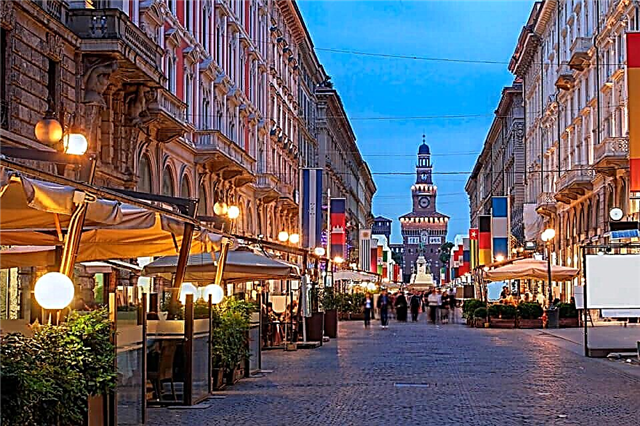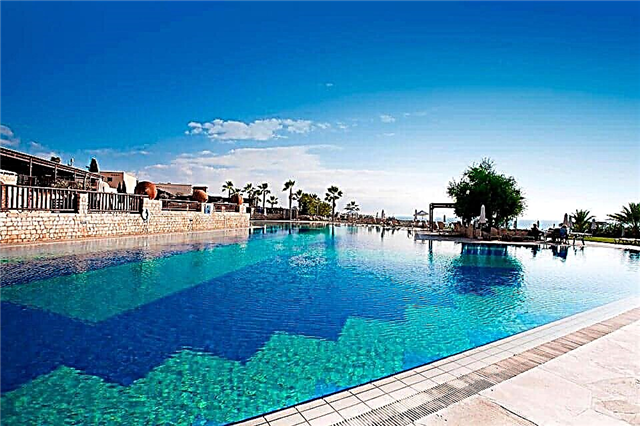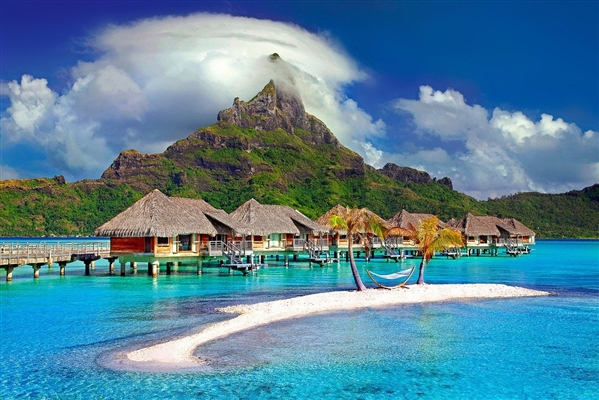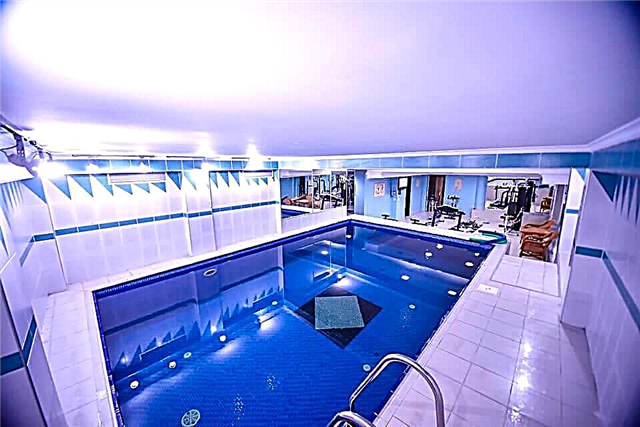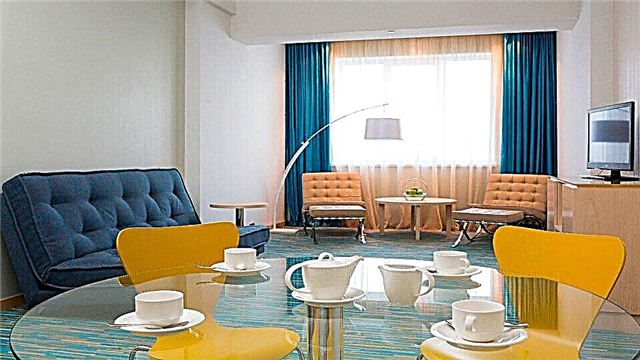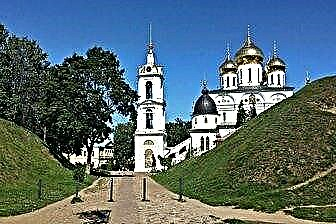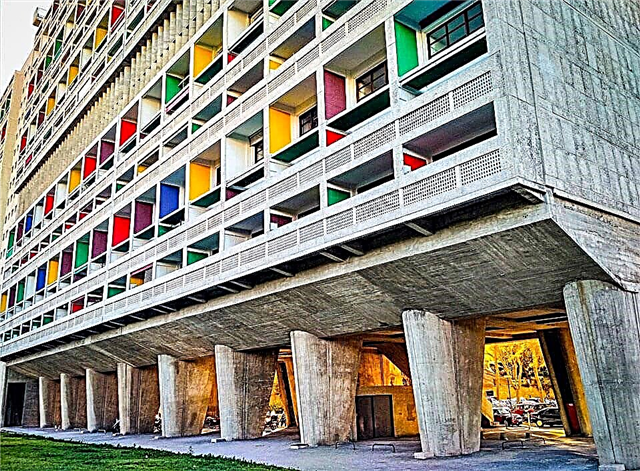Among the ancient cities of France, Marseille has a special tourist attraction - a city with a rich history dating back more than 2.5 thousand years. Its amazing atmosphere, created by the powerful forts built during the reign of the sun king Louis XIV, the sophistication of the baroque palaces and the amazing nature of the surrounding area, leave an indelible impression of your stay in the city. The sights of Marseille are a unique cultural heritage of the past centuries, preserved on city streets, collected in museums and modern amazing buildings. In addition to cultural treasures, tourists can enjoy the charm of the picturesque Marseille bays and unforgettable holidays on the amazing beaches of the Friuli Islands. Let's take a short excursion to places that a tourist would be unforgivable to miss.
Chateau d'If

The mysterious Chateau d'If, familiar to us from the descriptions of Alexandre Dumas in the novel The Count of Monte Cristo is a formidable fortress, which has become a visiting card of Marseille and an attraction for tourists. Built for defensive purposes against enemy attacks from the sea in the first half of the 16th century, it acquired the terrible fame of prison dungeons in Europe. The castle has been used as a prison since 1580 at the direction of King Francis I.
During its prison history, which lasted until 1880, its dungeons became a place of imprisonment for Huguenots, leaders of the Paris Commune, politicians and especially dangerous criminals. The remoteness from the coast and the danger of coastal sea streams made it impossible to escape from the impregnable fortress. For a fee, wealthy prisoners were allowed to socialize and walk on the site of the main tower, while the poor languished in the lower cells, which did not allow air and light to pass through.
In 1890, the Chateau d'If was opened to tourists, who are shown the chamber of Edmond Dantes on the 1st floor and the laz of Abbot Faria in it. On the 2nd floor, they are taken to the Iron Mask cell. After the tour, you can relax in the island cafe with an amazing view of the city. You can get to the castle by boat, departing from the Old Port in 20 minutes in the summer and in 1.5 hours - in the winter from morning to 17.00.
Abbey of Saint-Victor

The abbey of Saint-Victor, founded by the Monk Cassian at the beginning of the 5th century, is called the southern cradle of Christianity in France. The abbey was built on the site where the martyr Saint Victor of Marseilles, who died for the Christian faith, was buried. Over the centuries, the monastery was destroyed and rebuilt more than once, serving the faith of Christ until the French Revolution, after which it fell into decay.
Having become a historical monument in 1840, it was partially restored after 120 years. On its territory you can see the remaining large battlement wall and visit the upper church with a crypt, the entrance to which is opposite the bay of the Old Port through the Izran tower. After entering the temple, you will see a rare sarcophagus made of Carrara marble. Looking at the church relics, visitors admire the 5th century white marble altar and the statue of Saint Victor. The underground crypt contains a collection of marble sarcophagi from the 4th - first half of the 5th centuries and the tombs of bishops.
Here, the main church relic is also preserved - the priceless statuette of the Black Madonna, which leaves the crypt only to celebrate the Presentation of the Lord. The church and script are open daily from 9.00 to 19.00. Masses at the Abbey of Saint-Victor are held on weekdays at 6.30 am and 9.00 am, on Sunday at 9 and 11 am, accompanied by the divine sounds of a mid-19th century organ. Get to the Abbey of Saint-Victor by buses. From the Old Port No. 82 and 83, from the Cathedral of Notre Dame de la Garde, there is No. 60.
Panier district

Panier is the most picturesque and authentic part of the Old Town, inhabited mostly by immigrants from third countries. The history of the quarter, called in the old way Massala, dates back to 600 BC, when the Greeks founded it on this place not far from the port. Today the area can be compared to an open-air museum, the narrow streets of which are built up with picturesque buildings of the 16th-17th centuries. Passing here, you will want to stop near the white and pink Shelter of Mercy "Vieille Charite", built of stone in the Baroque style. Today it houses exhibitions of the Museum of Art of Africa and Egypt with numerous artifacts.
Notable is the three-hundred-year-old hotel "De Cabre" in the combination of the Gothic style with architectural details of the Renaissance. It is impossible to pass by the Diamond House with its façade adorned with diamond-cut stones. Its premises are given to the Museum of Old Marseille. In addition to these attractions, ordinary old painted houses, small art galleries and cozy cafes are also of interest, among which you should definitely relax in the historic 13 Corners bar, which is more than 200 years old.
Canebière street

Walking through the main street Canebière, which stretches for 1 kilometer from the Old Port to the Church of St. Paul, you can see a number of striking sights. Let's start our acquaintance with the street from the famous Mercure Beauvau hotel, where the composer Frederic Chopin and the writer Georges Sand stayed. Nearby is the building of the former luxury hotel Louvre et de la Paix with a facade decorated with four caryatids, symbolizing the four continents - Europe, Asia, America, Africa.
Now it houses a C&A store, where you can walk in and admire an elaborate old staircase and two salons with an interior that has been preserved from the 19th century. There is a plaque on the mission stating that it hosted the first screening of the Lumiere brothers' The Arrival of the Train. Walking along the Meyansky alley with three-window houses, you will come to the metal music pavilion of 1911, the fountain installed in the 30s of the last century, and the monument to the soldiers who defended Marseille in 1870.
It remains to admire the main attraction of the Canebière street - the Church of St. Paul with Gothic spiers, towering 69 meters into the sky. The founding of the church dates back to 1888. Its interior amazes with stained-glass windows depicting biblical scenes and saints of Provence, a carved wooden pulpit. Particular attention is drawn to the altar made of marble with onyx, colored enamel, gilded bronze and lapis lazuli.
The street can be reached by metro, leaving at one of 3 stations: from one end - Vieus Port (Old Port), from the other - Canebière (Canebières), and in the center - Noailles (Noal).
Buy bus tickets to Nice for 69,00 ₽
Buy bus tickets to Cannes for 299,00 ₽
Buy bus tickets to Toulon for 69,00 ₽
Boreli Park

Borely Park - named after its founder Joseph Borely, who belonged to one of the noble urban families. It was founded in the 18th century, and in the middle of the 19th century it became a public and favorite place for rest of the townspeople. There are several thematic gardens on its territory, created according to French and English models of landscape and park design. Walking through the park, visitors enjoy views of the herb garden, vine garden, Mediterranean, Japanese and Chinese gardens. Recently, the park has been added with a botanical garden, which delights with a bright palette of exotic plant species.
Here you will see many sculptures and a miniature copy of the Church of Notre Dame de la Garde, made from real plants. Picturesque waterfalls, ponds with waterfowl and otters, peacocks walking along the lawns color the amazing landscape. The decoration of the park is also the Boreli castle, built in the 18th century. Today it houses 2 museums: Decorative Arts and Archaeological. The park is located near the Prado beach, therefore, having rest under the canopy of trees, you can swim in the sea. You can visit this picturesque corner of nature from 6.00 to 21.00. Free admission.
Museum of Fine Arts

The Museum of Fine Arts is located in the east wing of the Longchamp Palace, built between 1839 and 1869. On the way to the palace, visitors are amazed at the wonderful view of the Water Castle cascade fountain, recognized as one of the most beautiful fountains in the world. The museum's collection was created in 1801-1804 from works of art expropriated from the bourgeois during the Great French Revolution.
The museum is especially proud of the collection of paintings, drawings and sculptures by one of the outstanding masters of Baroque art, Pierre Puget, who lived in the city for many years. A significant part of the collection is devoted to French painting and is represented by the famous seascapes of Claude Vernet, canvases by Jean Millet, Gustave Courbet, and masters of Provence painting.
The next section demonstrates Italian painting of the 16th-18th centuries with rare paintings by Tiepolo, Vasari, Perugino and other painters. The canvases of Antonio Pereda and José de Ribeira introduce the golden age of Spanish painting. From Flemish painting, art works of outstanding masters - Rubens, Jan Brueghel the Younger, Frans Snyders are exhibited here. The collection of the museum is complemented by several sculptures, including the famous work of Auguste Rodin, donated by the author. You can watch the unique collection: Tuesday - Sunday from 10.00 to 18.00.
Museum of European and Mediterranean Civilizations

The Museum of European and Mediterranean Civilizations began work in 2013, when Marseille was designated the European Capital of Culture. A modernist-style building was built especially for him, representing two parallelepipeds embedded one into the other. The inner box of the building, where the museum rooms are located, is supported by 308 fiber-reinforced concrete columns. The outer parallelepiped is an openwork concrete shell that protects the exhibits from the sun's rays.
Only one part of the glass wall remained open under the awning of the openwork concrete shell. Between the inner and outer walls from the ground floor, there is a ramp leading to the roof, connected to Fort Saint-Jean by a 115-meter bridge overhanging the sea. The expositions of the museum are represented by picturesque canvases, a collection of coins, household items, appliances, furniture and documents telling about the peoples of the Mediterranean, from the time of the conquests of the Roman Empire to the present.
There are also provocative exhibits here. One of them depicts a pregnant man, the other - a statue of Aphrodite made of aluminum and sequins. There are no analogues of this museum in the world. You can visit it every day except Tuesday in summer from 11.00 to 19.00, in winter until 18.00.
Cathedral of Sainte-Marie-Major

An architectural masterpiece, erected in the second half of the 19th century by three architects for 40 years. Each of the architects contributed to the architecture of the church building. Therefore, elements of Romanesque and Gothic architecture were interwoven into the traditional Byzantine style with round domes and elegant balustrades. The cathedral was conceived of impressive size: 142 meters long, with a height of each tower and dome of 60-70 meters, with a capacity of at least 3 thousand parishioners.
They did not spare valuable materials for the construction - marble from Cararra and onyx brought from Africa, so the cathedral attracts attention with the striped decoration of the walls of the facades, alternating white marble with green. The interior design of the temple is also unique, the walls of which are also made in 2 colors: beige and reddish marble. At the entrance to the cathedral, the beauty of the massive altar with a dome and columns, located in the center, attracts the eye.
In general, the interior perfectly combines Venetian mosaics with numerous sculptures of saints and bas-reliefs that delight with skillful execution techniques. Stained glass windows, frescoes and bronze decor create a special atmosphere of the church. The temple is open: Tuesday - Thursday from 9.00 to 12.00 and from 2.30 to 17.30, and from Friday to Sunday from 14.30 to 18.00. Directions - to the Colbert metro station.
Natural History Museum

The Natural History Museum is located in the right wing of the Longchamp Palace. Its foundation falls on 1819, therefore, the age of the museum has already exceeded 200 years. Museum expositions are located in 6 natural science sections: paleontology, botany, zoology, mineralogy, human evolution, flora and fauna of Provence. The paleontological collection contains more than 4 thousand samples of extinct representatives of the animal world.
The collection of the botanical section of the Mediterranean, consisting of herbaria, seeds and plants, has about 200 thousand exhibits. The next section is a zoological one, which occupies several rooms, and is represented by 12 thousand species of the world and Mediterranean fauna. The collection of mineralogy demonstrates the types of soils found on our planet, the types of native substances represented by gold, salt, ore.
The rich collection of stones, including precious ones, is especially attractive in this section. One of the expositions introduces the finds discovered during archaeological excavations, clearly traces the evolution of man. The collection of various sea shells, one of the largest in the world, is of great interest in the museum. You can get to the Longchamp Palace by metro, getting off at Longchamp station. The museum is open daily from 10.00 to 18.00, except Mondays.
Orange Velodrome Stadium

Sports fans can head to the popular Velodrome stadium, located near the center. It was built in the 30s of the last century and is famous for hosting the football world and European championships. Despite the name, the stadium lacks a cycle track that was dismantled in 1984 for the European Championship to expand the arena. After the reconstruction, the stadium began to accommodate more than 40 thousand fans. Today, the arena has been given over to the famous Marseille club Olympic for training and home games. Despite the stadium's rich history, the townspeople criticize its poor acoustics and the lack of a visor over the stands. The easiest way to get to the stadium is to take the metro to the Rond-Point du Prado station.
Notre Dame de la Garde

Rising on the top of a 150-meter hill, the Notre-Dame de la Garde basilica rises into the heavens with its bell tower, completed by an 11-meter gilded sculptural figure of Our Lady. The church, built in neo-Byzantine architecture on the site of an ancient fortress, is revered by the Marseilles as the heavenly patroness of the city. The first church building stood here from the beginning of the 13th century. The new building of the basilica was built at the beginning of the 15th century, and after another 100 years a fortress was erected around it.
At the end of the 18th century, due to looting, the church fell into decay, and a prison for noble people was created in the fortress, which was visited by the Duke of Orleans and Duchess Louise de Bourbon. The basilica was revived by the Catholic Church at the beginning of the 19th century. Inside, it is divided into an upper church and a lower church - script. The upper room is decorated with a mosaic depicting the Assumption of the Virgin and mosaic panels consisting of Venetian colored fragments. The floor covering is amazing with patterns in the Roman style.
The interior of the church features a white marble altar and a row of columns that combine white marble with red. In the crypt, attention is drawn to 2 marble statues of the 19th century - Bishop Marcel de Mazeno and Pope Pius IX. Behind the main altar is an 18th century sculpture of the Virgin Mary. The Basilica is open from October to March - from 7.00 to 18.15, and in the rest of the months the visit is extended by 1 hour.
Museum of the history of Marseille

Accidental ancient finds, found in the center at the construction site of a shopping center, served as the creation of the Museum of the History of Marseille. As a result, a museum complex was formed. One part of it housed exhibits in the museum building, and the other is an open-air gallery called the "Garden of Ruins". The history of the port city is traced in 13 sections of the museum, from its foundation in the 6th century BC to the middle of the 20th century.
Periods of urban history are shown with various objects of life: Greek, Roman, early Christian, Middle Ages. Interesting expositions highlighting the entry of Marseille into France, the monarchy, the Great Revolution and the two world wars of the XX century. Historical periods are represented by fragments of buildings, sculptures, objects of labor and everyday life, clothing and adornments.
The collection of sunken ships in the Mediterranean is impressive. The oldest exhibit is more than 2.5 thousand years old. Going to the "Garden of Ruins", you will stroll among the architectural rarities dating back to the 6th-2nd centuries BC. The museum, open to the public every day from 10.00 to 18.00, except Mondays, can be reached by metro Colbert and Vieux-Port Hotel de Ville. Free admission on Sundays.
Longchamp Palace

The palace complex of Longchamp is a luxurious architectural ensemble consisting of a sculptural fountain group, a two-winged palace with a facade with a remarkable triumphal arch and a symmetrical Corinthian colonnade. The cascade fountain "Сhateau d'Eau" with a symbolic group of sculptures appears in front of the palace in all its beauty and luxury. The composition is represented by four bulls, ruled by a woman who personifies the Durand River.
Near her you will see two beautiful ladies, next to whom are children with ears of corn and grapes. From the fountain, the water flow is directed to the middle pool, from where the water flows into 12 fountains in the form of bowls, lined up along the steps. Behind the fountain, an arch in the form of a grotto attracts the eye, on which birds, nymphs and flowers are visible.
The arched vault is decorated with the coat of arms of Marseille, surrounded by two mermaids. The symmetrical wings of the palace with rich interior decoration are occupied by the Natural History Museum and the Museum of Fine Arts. At night, the Palace enchants with the magical view created by the illumination. Opposite the palace there is a luxurious French park with an observatory and a botanical garden with centuries-old elms, plane trees, oaks and numerous sculptures along the alleys. It is convenient to get to the palace by subway to Cinq Avenues Longchamp station.
Fort of St. Nicholas

The fortress, named Fort Saint-Nicholas, was built in the 17th century by order of King Louis XIV in 4 years in order to intimidate the Marseilles, who were raising uprisings. The walls of the fort were lined with pink-colored stones brought from Couronne, and the cannons were directed towards the city. Earlier, on the site of the stone citadel, there was a 13th century chapel that belonged to the Abbey of Saint-Victor.
In the XIV century, the chapel was assigned the role of a chain tower. A chain was attached to the wall, blocking the way to the port water area for unfriendly ships. During the French Revolution, the fort was partially destroyed by the townspeople, after which patches of gray stone appeared on its wall. From the first half of the 19th century until the end of World War II, the fortress housed a prison.
With the beginning of the construction of the boulevard to the Palace of Faro, the citadel had to be cut into two parts. Since the last century, the fort has acquired the status of a historical monument. Only one part of it is open to tourists. The center of the fortress, occupied by the Foreign Legion, is closed to the public. On the territory of the fort, the building of the old mill was turned into a memorial dedicated to the victims of war. Opening hours from 9.00 to 18.00, entrance through the eastern gate.
Kalanki National Park

The coastline from Marseille to the town of Cassis is cut by nature with small picturesque bays, called in French - calanques. The delightful beauty of this stretch of coast has led to the creation of the National Park of Calanques, protected by the state. For excursions, the territory of the park is divided into 3 sections.
- “Simple” calanques, stretching from the port of La Madrague to the port of Le Goudes and the Callelongue bay on the southwestern coast of the city, where the reserve begins behind the cape. The bay, surrounded by picturesque hills, is equipped with mooring places for pleasure ships, a beach, houses on the coast. A road leads to the bay.
- The "rocky" calanques Sormiou, Morgiou and Sugiton, stretching along the southeastern coast of Marseille, are distinguished by deep rocky coves with small villages along the coast. The calanques of Sormiou and Morgiou have a small port, beaches and a road to the sea. The most beautiful calanque on this coast is considered To the sea with a wild beach, a road leads through a coniferous forest and past rocky gorges.
- The "tourist" calanques Port-Miou, Port Pin and En-Vau, located on the west coast of the town of Cassis, are the most visited by tourists. These bays go especially far into the coast. The pictures of stripes of the azure sea, surrounded by high whitish rocks with green splashes of trees, are striking. There are two routes along the tourist calanques on excursion boats from the port of Marseille or the port of Cassis.
You can visit the first two groups of calanques of the National Park on your own by bus, car or boat. Buses leave from Plaza Castellane.
Grobe-Labadier Museum

The Grobet-Labadier Museum is named after the Grobet-Labadié spouses, who donated their art collection to the Marseilles along with a 19th century mansion. The museum exhibits include the living rooms of the house with rare antique furniture, objects of cultural value and paintings. Walking along the first floor of the museum, you will see a reception room with paintings, a salon with an old harpsichord, a boudoir and a dining room furnished with furniture from the 17th – 18th centuries. Here you can also admire the rare collection of porcelain.
On the second floor, visit the Early Art Study, which presents a collection of decorative objects, furniture from European and Asian paintings of the 14th-16th centuries. Entering the cabinet of curiosities, you will see many objects that were considered funny by the owners.
The most interesting collection is displayed on the 3rd floor. The vast collection of locks and keys dating back to the 14th century amazes here. The reception area is amazing with an exhibition of rare 15th century carpets and a collection of sculptures. The highlight of the museum is the music room of the owner Louis Grabé, who has assembled a rare collection of fancifully decorated and painted musical instruments from different countries of the 17th - 19th centuries. The museum accepts visitors daily from 10.00 to 18.00, except Mondays, travel to the Cinq Avenues Longchamp subway.
The old almshouse of Viel Charite

Viel Charite, formerly a poorhouse, is located in the center of the historic Panier district, close to the Cathedral. It was built in the Baroque style in the first half of the 17th century. In 1707, a church was erected near the almshouse. The material for the construction of Viel Charite was the white and pink Couronne stone.
The building of impressive size in the shape of a rectangle 112 by 96 meters has 4 buildings, without windows on the outer facade. Each building consists of 3 floors with arcade galleries on each floor overlooking the courtyard, in the center of which there is a church built in the Italian Baroque style, topped with an oval dome.
The pediment of the church façade depicts an allegorical figure of Mercy surrounded by pelicans with chicks meeting poor children. The entrance to the church is decorated with 4 Corinthian columns. The almshouse received the first beggars and wretched people in 1641. Now it houses 2 museums: archeology and art of Africa and Oceania. Nearest Metro to Viel Charite – Colbert Hôtel de Région station. You can visit the museums from 10:00 to 18:00 from Tuesday to Sunday.
Old port

The old port served as the foundation of Marseille by the Greeks - Phocians, who moored the local coast 6 centuries BC. Originally the settlement was called Massalia. In the 5th century, the Abbey of San Victor appeared here. Already from the X-XIII centuries on the coast of Lasidon Bay, berths for ships, warehouses and shipyards, where warships were built, were equipped. Workers settled near the shipyard. In the 13th century, the fort of St. John was erected to protect the population.
Starting from the 15th to the 18th centuries, the construction of rich mansions and secular buildings began here, which are now included in the list of Marseilles attractions.Before the construction of the new port in the 19th century, the centuries-old marina was the city's sea gate. Today, the territory of the Old Port is favored by yachtsmen and seafood merchants.
People come here to admire the yachts, take an exciting sea excursion on a boat seeing the city panorama from the sea, or sail to the mysterious castle of If. The fish market on the Belgian embankment amazes with a diverse range of Mediterranean gifts, and you can enjoy their taste in any port fish restaurant.
Mirror awning by Norman Foster

In 2013, the central embankment of the city was replenished with a modern attraction - the Norman Foster Mirror Awning for various themed events. It was built in the form of a canopy measuring 46x22 meters, made of polished steel. The structure is supported by inconspicuous thin columns. The mirrored surface of the awning, reflecting the surroundings of the Old Port, has transformed the embankment. Famous French designer Michel Devignem worked on the landscape design of the awning area, created by the architect Norman Foster.
He laid out the surface under the awning with a light granite covering on one level, which made the structure visually lighter and more airy. Tourists liked to look at themselves in the mirrored sky so much that the city authorities had to make the embankment a pedestrian one because of their influx. The pavilion not only served to improve the space around the harbor, but was also used for various events and fairs.
Housing unit Le Corbusier

The Marseille project "Housing", which is a "city within a city", was developed by the architect Le Corbusier. The embodiment of the idea was a residential complex on Boulevard Michel, built in 1952 for 1600 people and 337 apartments. All apartments are equipped with a balcony protected by sun screens to ensure through ventilation.
One of the most important innovations of the “residential unit” was the placement of apartments with ordinary and two-level living quarters. The apartments, spread over 18 floors, stretch along each side of the building. The house is notable for five “inner streets” corridors. On the middle street, called shopping, residents enter shops and service establishments. Without leaving their homes, residents were able to relax on the roof in the garden, run on a treadmill, work out in the gym, swim in the pool and leave the kids in kindergarten.
Reinforced concrete was used for the construction of the Residential Unit. The grandiose volume of the house is supported by massive columns that serve to create a public garden under the building for relaxation and meetings.
To look at the "residential unit" you need to take bus 22, 521, B1 and get off at the Le Corbusier stop
Tourist train Petit Train

The first acquaintance with the city is best done on the tourist mini-train Petit Train, which departs from the Old Port area opposite the town hall. Two routes are open from April 1 to December 31, while the third is open during the summer. The first route takes you on a guided tour of the Old Town, passing by the Cabre mansion, which houses the luxurious Hotel de Cabre, the Hotel Dieu, the Saint Laurent Church and the majestic Cathedral of the Major.
The train will stop at the old almshouse "Vieille Charité". At this stop, passengers get acquainted with the authentic Panye quarter, which touches old streets with colorful houses, squares - Lenche and Moulins. The main target of the second mini-train tour is the Church of Notre Dame de la Garde. Before it, the train passes along the coast of the city, where the fort, the palace of Faro, and the abbey of St. Victor appear before the eyes of tourists.
Stopping near a high hill on which the Church of Notre Dame rises, tourists inspect the temple. The third route is open during the summer to the Friuli Islands. The Petit Train travels along the sea coast, where tourists have time to look at the old Caroline hospital, the St Esteve beach, stretching near the Ratonneau fortress, the panorama of the Chateau d'If and the bay of Marseilles. On the way back, the mini-train stops for half an hour to explore the Notre Dame de la Garde basilica.
Catalan beach

Plage de Catalan is located near the city center, a 15-minute walk from the Old Port. Although it is not particularly beautiful, it is convenient for the rest of tired tourists from sightseeing and townspeople. The beach is covered with fine sand, so no special shoes are needed. There is shallow water near the coast, there are no stones and sharp dips under the water. There is slight excitement on the sea surface, but there are no big waves.
A breath of light breeze creates an atmosphere of freshness, smoothing out the summer heat. Due to the proximity of the port, the water in the water area of the beach is not perfectly clean. The highlight of the beach is the area with anatomically shaped stones, where you can comfortably sunbathe and take a picturesque selfie. Boulders are scattered among the sand and do not interfere with the passage. The beach is famous for its numerous volleyball courts, which gather fans of this game. On Catalana you will not see sun beds and umbrellas, everyone comes with his own towel and spreads it where he finds a place. In the evening, young people like to have picnics here, relax in the coastal bars and nightclubs.
Prado beach

Du Prado beach consists of a whole complex of artificially created beaches, stretching along the sea coast of the city. The Prado is a large 26-hectare seaside park, created as a mound from the remnants of the rock obtained during the construction of the metro. Of the 3.5 kilometers of the total length of the complex, 2 kilometers are occupied by beaches. On the remaining area of the coastline, parks were laid, sports grounds and marinas were equipped. The most suitable beaches for swimming are Roucas Blanc, Bonneveine, Vieille Chapelle and Borely.
Several beach areas where there is a wave are reserved for water sports: windsurfing, kiting, water skiing, diving. There are centers for amateur sailing, boating and canoeing and other water sports. Along the coast there are many beach volleyball courts and lawns for those who like to play football. The beaches are equipped with the necessary infrastructure: parking lots, changing rooms, showers. Toilets and equipment rental points. There are many cafes and restaurants near them. You can get to the Prado beaches by bus number 19 from the "Rond Point du Prado" or bus number 83 from the Old Port.
Observatory

The Marseille Observatory is a professional astronomical complex that unites the Astrophysics Laboratory, the Haute Provence Observatory, the Stellar and World Interference Laboratory, the Gassendi Department. The first observations at the Marseilles observatory date back to 1702, when it was founded by the Jesuits. In the second half of the 18th century, the observatory received the status of the Royal Observatory of the Navy, where two experienced astronomers began to work.
At this time, the observatory was replenished with a powerful 6-foot telescope at that time. During its existence, the observatory has undergone changes, without changing the scope of activity, conducted scientific observations and searches for asteroids. Its employees own a number of discoveries. You can take an excursion to the observatory, where you will see many unique ancient and modern instruments for studying the Universe. It is located in the Bouches-du-Rhone area. You can visit the observatory with a guided tour.
Faro Palace

The Faro Palace, lined with pink stone, shines with its beauty on the site of a high hill of the cape of the same name near the sea. It is supported by the cliffs of the steep coast. The building of the Palace was built for Louis Napoleon in the second half of the 19th century. The decoration of the palace facade is skillful stucco molding, small graceful balconies and false columns. Window openings of the building are rounded, and on both sides of the main staircase there are flower beds and shrubs. The windows of the three-storey palace offer stunning views of Marseille and the Château d'If.
The building consisted of 500 rooms, decorated in the Empire and neoclassicism styles.At the beginning of the 20th century, two wings were added to the palace building, violating its architectural style. The palace is surrounded by a picturesque landscape park with several viewing platforms, from where it is pleasant to admire the colorful panorama of the city. Sitting in the restaurant-terrace, you will enjoy admiring the seascape of the harbor. The palace is especially magnificent in the evening illumination, which gives it fabulous features. You can get there by metro, getting off at the Vieux-Port station, then take bus # 83.
Augustinian church

The snow-white facade of the Catholic Church of Saint-Ferrol, belonging to the Augustinian Order, adorns the Belgian embankment in the Old Port. Its building was built for over 100 years (1447-1588). There are several chapels in the church, built by different guilds of craftsmen in honor of their patrons. A snow-white facade and an octagonal bell tower made in the neoclassical style, which appear before contemporaries, were erected at the beginning of the 19th century.
In the niche below the pediment, the parishioners are greeted by the Immaculate Conception statue made by the sculptor Coulange. Above the portal at the entrance is a statue of Jesus Christ. If you look at the other walls of the facade, you will see features of bygone eras - Baroque and Romanesque styles. The interior of the temple has three naves, erected during the Baroque fashion. There are 6 chapels in the side naves, where the remains of noble families and clergy are buried.
In the interior of the temple, the central place is given to the altar of St. Peter and the pulpit of the 17th century, decorated with wooden sculptures. Among the church relics you will see the remains of a tomb with an altar, a reliquary of St. Louis of Anjou, a wooden bust of St. Ferrol from the 18th century made in gilding, and a baptismal bowl with a high relief of an angel inside. The Augustinian church is open daily from 9.00 to 18.00, admission is free.
Fort of saint john

Initially, from the 12th century on the site of the modern fort of St. John, built in 1860 during the reign of Louis XIV, there was a fortress of the knights-crusaders. The main purpose of the construction of the new fortress was to intimidate the inhabitants after the city uprising. For this, the muzzles of the cannon from the fortress were directed towards the city. After the French Revolution, there was a prison in the fortress, where noble prisoners were kept.
During World War II, ammunition depots were located here, and when an explosion occurred in one of the depots, part of the fortress was badly damaged. Today, on the territory of the fortress, the ancient Rene tower and the old lighthouse, the ruins of the old barracks are of interest. There is also the chapel of St. John, who is considered the patron saint of the fortress, and a monument to prisoners who died in Nazi camps.
Since its restoration in 2013, Fort St. John has housed two sections of the Mediterranean History Museum: The Mediterranean Gallery and The Time of Rest. The fort is connected with the new building of the museum, built nearby, by suspension bridges. You can see the fort and the museum exposition every day, except Tuesday in the summer from 11.00 to 19.00, in winter until 18.00.
Ile du Frioul island

The le du Frioul archipelago consists of 2 large islands: the northern Ratonneau and the southern Pomegues, as well as 2 small islets, one of which is the famous If. Large islands are connected by a bridge. Behind it is a harbor with anchorages of ships and a series of residential buildings. The islands of Ratonneau and Pomegues have the status of protected areas belonging to the Calanca National Park. On their territory, on a stone landscape, 350 species of vegetation grow, many different birds live, there is a mysterious cave with wall inscriptions made by the inhabitants of the Paleolithic era.
Most of the coves on the islands are suitable for swimming. The coast of Ratonneau Island is popular for its ancient fort and public beach. St. Esteve. It has all the necessary amenities for a pleasant stay: showers, toilets, lifeguards work. The beach is connected to the harbor by a road with tourist road trains. The best observation deck is located in the north of the archipelago - Cape Cap de Croix. There are special trails for walking. On the southern island of de Pomegues, the remaining fragments of a medieval fortress are of interest to tourists.
Stock Exchange Palace

The monumental structure of the Stock Exchange Palace with a facade flanked by powerful Corinthian columns was erected in 1860 for the city's Chamber of Commerce. The neoclassical palace on the main facade of 2 floors is fenced by porticoes of 10 columns, under which there are 5 massive doors in the form of arches, bordered with stone. The roof of the building was crowned with the city's coat of arms and bas-reliefs.
On the pediment, the working hours of the famous French master are set. Casting a glance at the side portals, you will see Corinthian pilasters and sculptures of sailors, symbols of trade and shipping. Black and white marble prevails in the design of the large hall of the stock exchange, which can accommodate up to 2.5 thousand people. On the ceiling vault, a relief panel serves as a decor.
Covered galleries are located along the perimeter of the hall, serving as offices of stock exchange traders. Today, in addition to brokerage offices, the Exchange Palace houses shops, as well as cultural institutions - the Maritime Trade Museum, a public library, and various thematic exhibitions are often organized. Shops are open from Monday to Saturday from 10.00 to 19.30, travel to the Exchange Palace to the Vieux-Port Hotel de Ville metro station.
Vestige Garden

Among the high-rise buildings, the Jardin de Vestige garden, called the Garden of the Ruins, stands in striking contrast. It bears the status of a National Park, created around the ruins of Massalia - the cradle of the city that arose 2.6 thousand years ago and was destroyed by the warriors of Gaius Julius Caesar in the 1st century BC for insubordination.
The city was revived 6 centuries after its destruction as Marseille. Ancient ruins were discovered during the construction of the Central Exchange. Visitors to the Garden of Ruins will walk along trails created in the distant Roman era; former docks have been turned into green lawns. In the hewn stones laid out in the garden, one can see the holes made by the ancient builders for laying the walls. In the distant ancient era, he transfers the inspection of the foundations of residential buildings, the ruins of fortress walls and defensive towers in the IV-I centuries BC, which served to protect the city.
The effect of the presence in the Roman era is enhanced by antique burial urns and slabs, ancient boats standing in the open air. To replenish your knowledge of the history of Massalia, you can visit the Museum of the History of Marseille, located near the Garden. You can get to the Vestige Garden by metro to Vieux-Port (line 1) or Noailles, Jules Guesde (line 2). All days, except Sundays, the park is open for visits from 9.00 to 18.30.

